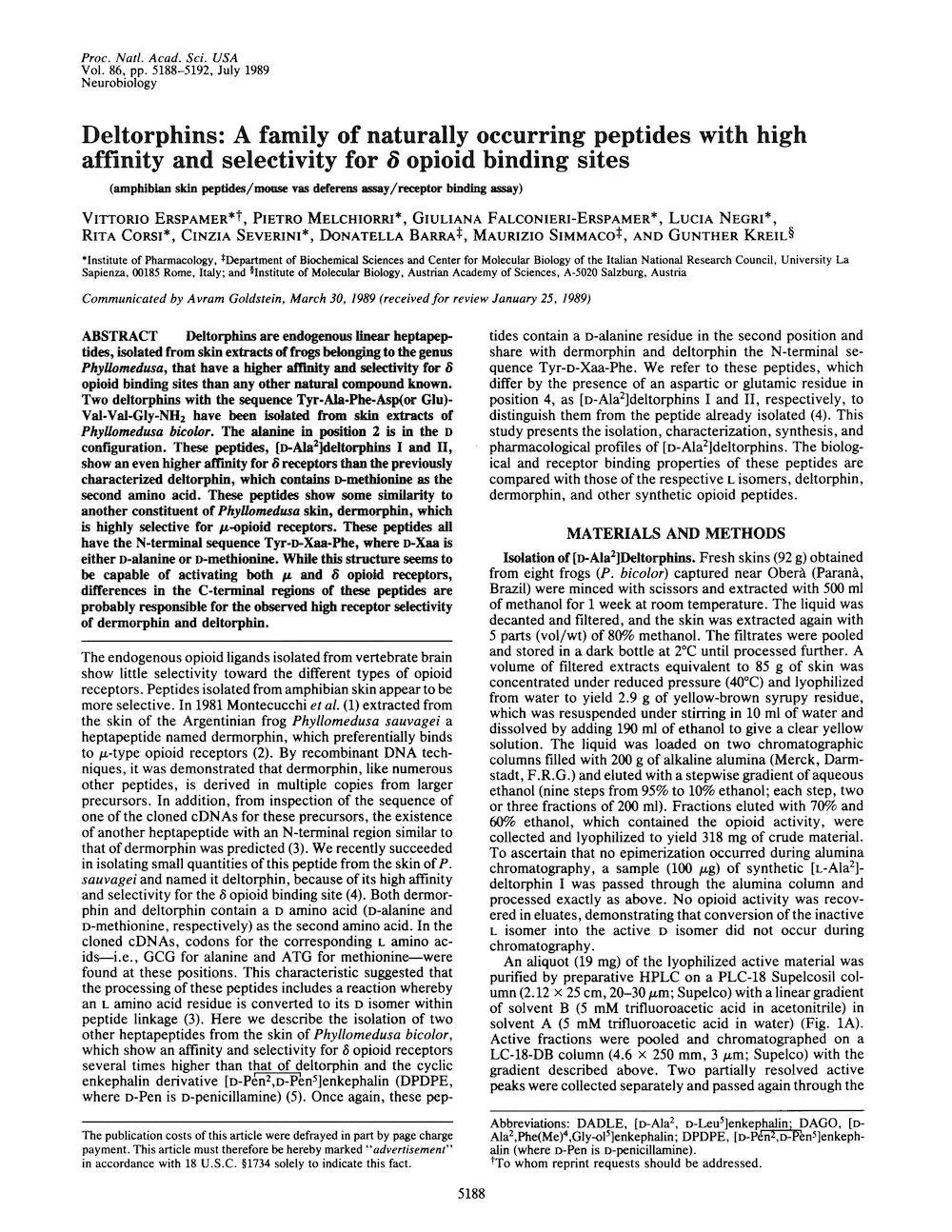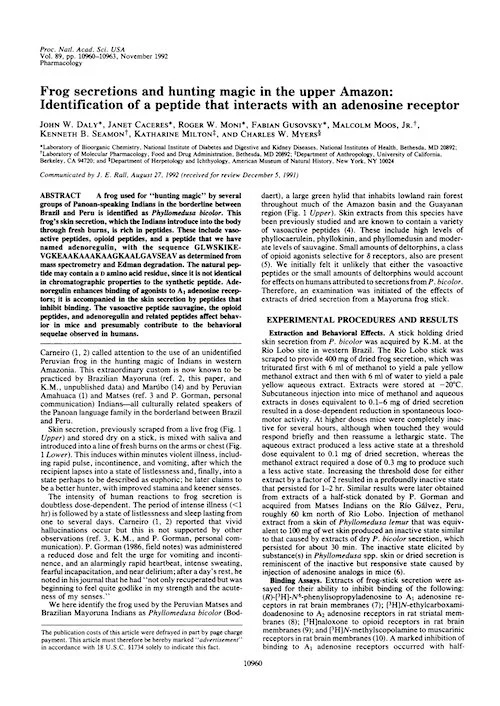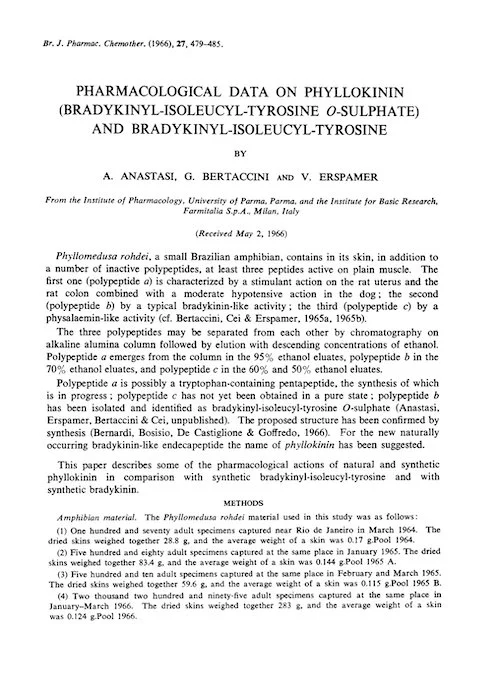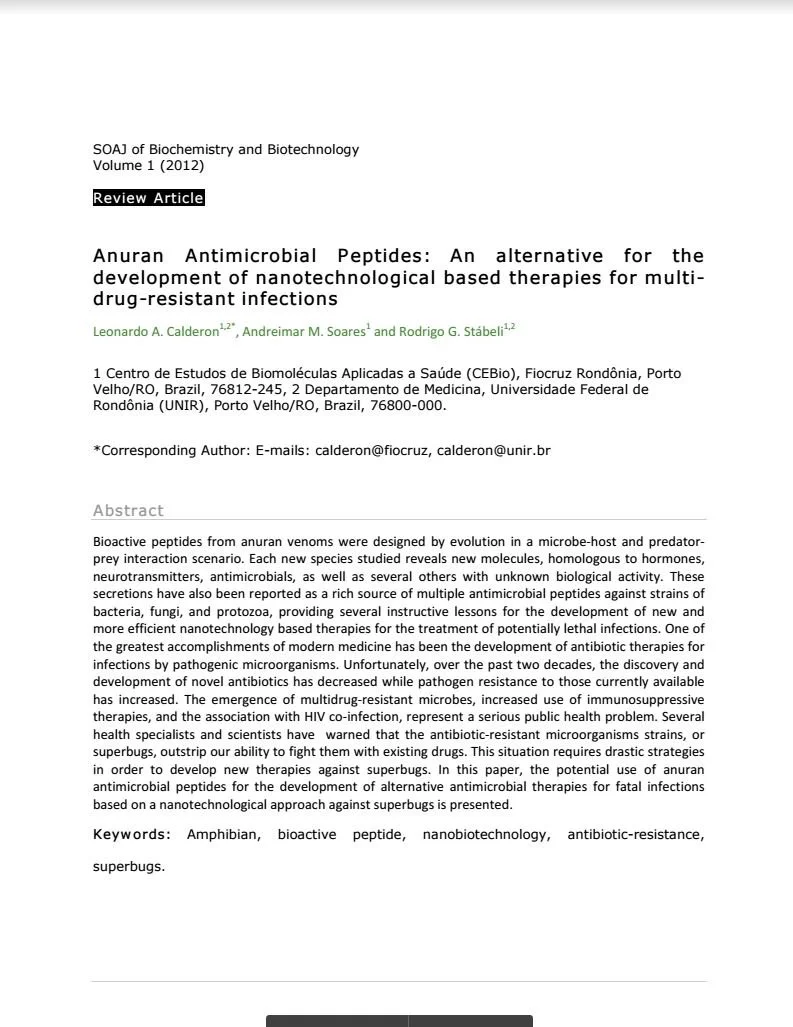
Science of Kambo
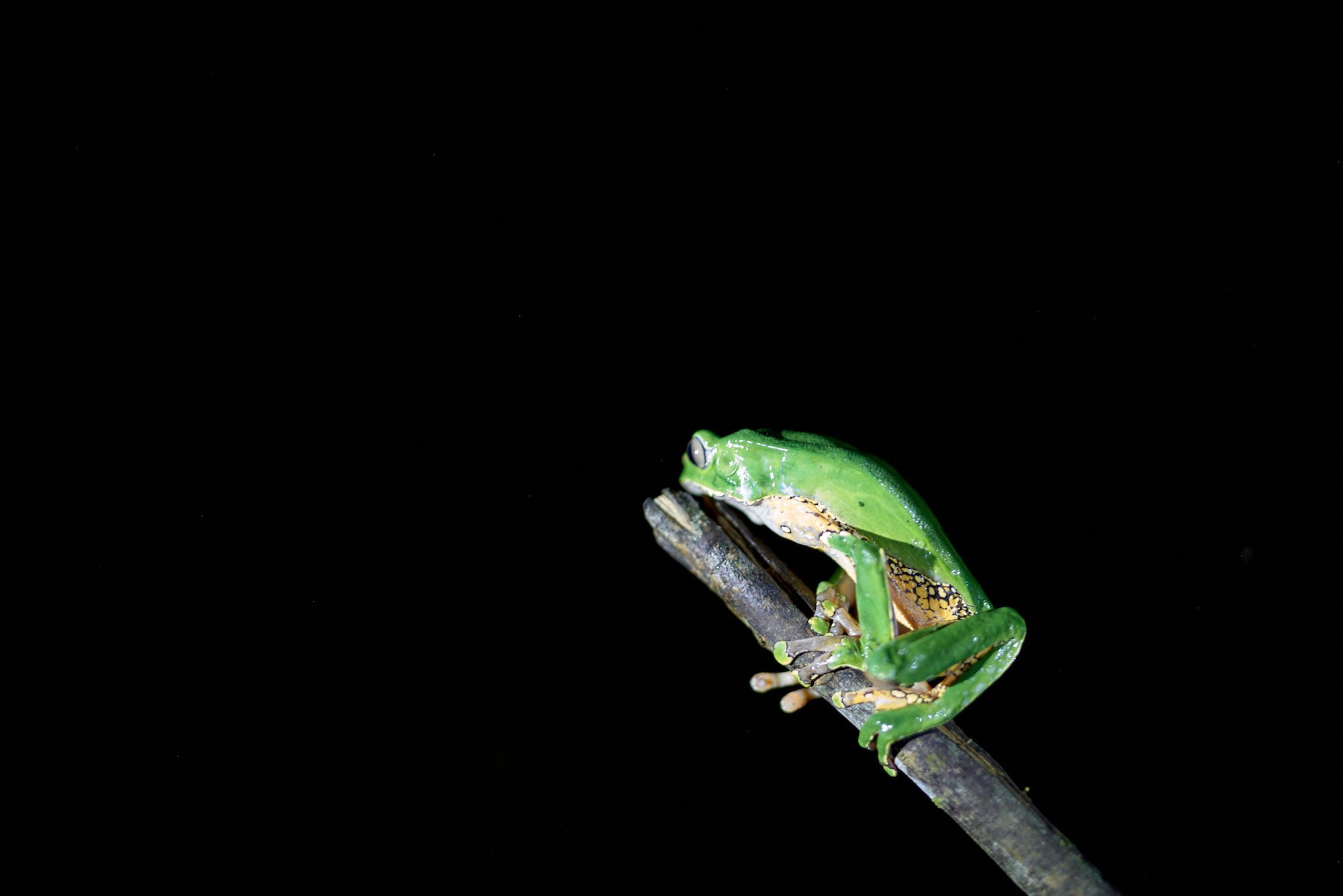
“a fantastic chemical cocktail with potential medical applications, unequaled by any other amphibian”
Kambo Research and Science
Scientific research on the secretion of Phyllomedusa bicolor started in the 1980’s. Nominee of the Nobel Prize, scientist Vittorio Erspamer of the University of Rome wrote that the secretion contains a ‘fantastic chemical cocktail with potential medical applications, unequaled by any other amphibian’.
Kambo contains a unique and complex blend of bioactive peptides that can initiate chemical reactions in the human body, some of which can enhance sensory perception, physical strength, and the ability to manage pain and stress. These peptides have a broad range of potential medical applications, including the treatment of brain disorders like Parkinson's and Alzheimer's, as well as depression, migraines, circulatory problems, organ diseases, skin and eye issues, fertility problems, AIDS, hepatitis, and cancer.
In addition to its medicinal properties, Kambo has anti-inflammatory, antimicrobial, and antiviral effects and can aid in the healing of infections. Due to the presence of certain peptides, Kambo is one of the strongest natural antibiotics and anesthetics in the world and one of the strongest, natural ways to empower our immune system.
Kambo treatments can have both short-term and long-term effects. In the short term, they can increase alertness, mood, resistance to fatigue, hunger, and thirst, the ability to concentrate, and a calm mind that can last for several days or weeks. In the long run, Kambo can improve overall health, overcome fatigue, and strengthen the immune system. If you are interested in researching the peptide families found in Kambo, they are listed below:
Kambo Research
Collected below is just some of the research into Kambo and its peptide families. If you come across any more research papers or information that is not listed here, please let me know.
Leonardo de Azevedo Calderon • Alexandre de Almeida E. Silva • Pietro Ciancaglini • Rodrigo Guerino Stábeli
Screening for new bioactive peptides in South American anurans has been pioneered in frogs of the genus Phyllomedusa. This genus has been reported as a ‘‘treasure store’’ of bioactive peptides.
Antitumor and Angiostatic Activities of the Antimicrobial Peptide Dermaseptin B2
Hanneke van Zoggel, Gilles Carpentier, Ceélia Dos Santos, Yamina Hamma-Kourbali, José Courty, Mohamed Amiche, Jean Delbé
Skin secretions of the Amazonian tree frog Phyllomedusa bicolor contains molecules with antitumor and angiostatic activities, one identified as the antimicrobial peptide dermaseptin (Drs) B2.
Dermorphin-related peptides from the skin of Phyllomedusa Bicolor
Lucia Negri, Giuliana Falconieri Erspamer, Cinzia Severini, Rosa Luisa Potenza, Pietro Melchiorri, Vittorio Erspamer
Three naturally occurring dermorphin-like peptides from the skin of the frog Phyllomedusa bicolor, the related carboxyl-terminal amides, and some substituted analogs were synthesized, their binding profiles to opioid receptors were determined, and their biological activities were studied in isolated organ preparations and intact animals.
Vittorio Erspamer, Pietro Melchiorri, Giuliana Falconieri-erspamer, Lucia Negri, Rita Corsi, Cinzia Severini, Donatella Barra, Maurizio Simmaco, Gunther Kreil
Deltorphins are endogenous linear heptapeptides, isolated from skin extracts of frogs belonging to the genus Phyllomedusa, that have a higher afinity and selectivity for opioid binding sites than any other natural compound known.
John W. Daly, Janet Caceres, Roger W. Moni, Fabian Gusovsky, Malcolm Moos, Jr., Kenneth B. Seamon, Katharine Milton, Charles W. Myers
A frog used for "hunting magic" by several groups of Panoan-speaking Indians in the borderline between Brazil and Peru is identified as Phyllomedusa bicolor. This frog's skin secretion, which the Indians introduce into the body through fresh burns, is rich in peptides.
Pharmacological Data on Phyllokinin
A. Anastasi, G. Bertaccini, V. Erspamer
Phyllomedusa rohdei, a small Brazilian amphibian, contains in its skin, in addition to a number of inactive polypeptides, at least three peptides active on plain muscle.
Kambô, The Spirit of the Shaman
Marcelo Bolshaw Gomes, Professor of Sociology of Comunication UFRN (Federal University of Rio Grande do Norte, Natal)
“Kambô circulates in the heart. Our shaman said that when we take Kambô it makes the heart move accurately, so that things flow, bringing good things to the person. It is as if there was a cloud on the person, preventing the good things to come, then, when it takes the Kambô; it comes a ‘green light’, which opens its ways, making things easier.”
Kambo and its Multitude of Biological Effects: Adverse Events or Pharmacological Effects?
Jan M Keppel Hesselink, Professor of Molecular Pharmacology, Department of Health, University of Witten/Herdecke, Germany; Institute for Neuropathic Pain, Bosch en Duin, The Netherlands
The secretion of the frog consists a number of bioactive peptides and within few minutes after intake, nausea, vomiting, facial edema, palpitations and hypotension can occur. In the pharmacological and medical literature, these are reported as transient adverse events, although in essence the reactions are purely pharmacological.
Major biological effects induced by the skin secretion of the tree frog Phyllomedusa hypochondrialis
Katia Conceição, Fernanda Miriane Bruni, Marta M. Antoniazzi, Carlos Jared, Antonio Carlos M. Camargo, Mônica Lopes-Ferreira, Daniel C. Pimenta
This work aims to describe the main physiopathological properties of the tree frog Phyllomedusa hypochondrialis skin secretion, obtained by manual stimulation of the dorsal skin surface.
Natural Products as a Foundation for Drug Discovery
John A. Beutler, Molecular Targets Development Program Center for Cancer Research National Cancer Institute
This overview aims to inform pharmacologists of current strategies and techniques that make natural products a viable strategic choice for inclusion in drug discovery programs.
Kambô: Scientific Research and Healing Treatments
Giovanni Lattanzi
Scientific research on kambô: nine powerful bio-active peptides. Originally, 53 tribes used this secretion but now only 13 small tribes still use it. It is used to get rid of ‘panema’, the name they give to bad luck, as well as for ‘hunting magic’ and as a powerful medicine against snake bites, malaria, yellow fever and other epidemic diseases.
The dermaseptin superfamily: A gene-based combinatorial library of antimicrobial peptides
Pierre Nicolas, Chahrazade El Amri
Skin secretions of hylid frogs show amazing levels of interspecific and intraspecific diversity and are comprised of a cocktail of genetically-related, but markedly diverse antimicrobial peptides that are grouped into a superfamily, termed the dermaseptins, comprising several families.
Leonardo A. Calderon, Andreimar M. Soares, Rodrigo G. Stábeli
Bioactive peptides from anuran venoms were designed by evolution in a microbe‐host and predator‐ prey interaction scenario. These secretions have been reported as a rich source of multiple antimicrobial peptides against strains of bacteria, fungi, and protozoa, providing several instructive lessons for the development of new and more efficient nanotechnology based therapies for the treatment of potentially lethal infections.




